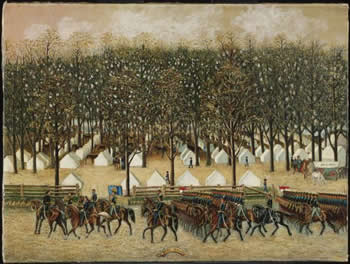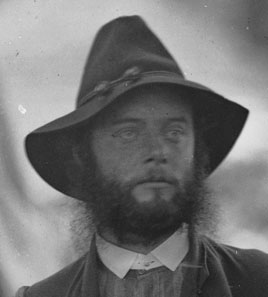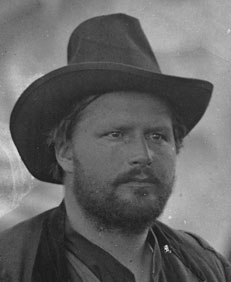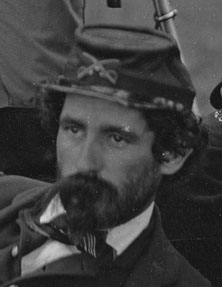Command of the 4th Pennsylvania Cavalry at Antietam
16 November 2008
Eric Wittenberg has put up a fine post featuring James Childs, Colonel, 4th Pennsylvania Cavalry, killed at Antietam on 17 September 1862. Elements of the Fourth were among the few Union cavalrymen engaged at Sharpsburg that day – the Federal mounted arm was not a major factor in the battle.
Eric’s study – and that distinctive photograph of the Colonel – reminded me of a gap in my digital collection of portraits. In particular the face of the man who followed Childs in command of the unit, his Lieutenant Colonel James K. Kerr. As usual, looking for Kerr led to other serendipitous connections and people … thanks Eric!


Fourth Pennsylvania Cavalry [McClellan Drilling Troops, 1861] (artist unknown, Phila Museum of Art)
The 4th Cavalry (64th Regiment of the line) was recruited from Pittsburgh and counties of Allegheney, Indiana, Lebanon, Luzerne, Northampton, Venango, and Westmoreland. Organized in August and September 1861. They formed first at Camp Curtin (Harrisburg), but soon moved to camp near the Soldiers’ Home in Washington DC, where they were mustered into Federal service in October with three battalions of four companies each. The original field officers:
- David Campbell, Colonel
- James H. Childs, of Pittsburg, Lieutenant Colonel
- James K. Kerr, of Venango county, First Major
- William E. Doster, of Northampton county, Second Major
- James H. Trimble (or James T. Trembell), of Westmoreland county, Third Major
Apparently the regiment very nearly became infantry before they ever saw action. As Bates* has it …
The greatest drawback was the difficulty experienced in getting suitable horses. So late as the 1st of March, 1862, only six companies were fully mounted, and one other partially so. Four of these companies were acting as provost guard in the city of Washington. An ingenious piece of strategy was practiced to mount the balance. The captains of companies not mounted, procured an order authorizing them to select a certain number of disabled horses from the corral daily, until all were supplied. These were immediately traded for those ridden by the companies on guard in the city. On inspection day, these worthless animals were condemned and the men directed to draw sound ones from the corral for artillery horses. In point of morality this action is indefensible; but it saved the regiment from disbandment, and is hence not without some redeeming qualities…
The cavalry arm of the service was not at this time in favor, and many organizations were transformed to infantry. Through the influence of prominent members of Congress from Pennsylvania, this one was preserved intact …
On the 12th of March, Colonel Campbell resigned, to take command of the Fifth Cavalry, and Lieutenant Colonel Childs was promoted to succeed him. Major Kerr was promoted to Lieutenant Colonel, and Captain George H. Covode [Co. D], to Major.
I believe that was the command team Gardner photographed on the Virginia Peninsula in August 1862, and the men who would lead the Regiment at Antietam in September:


Col. J. H. Childs and staff, Westover Landing, Aug. 1862 (A. Gardner, coll. Library of Congress)
So who’s who in this photograph?
The man on the right wearing Lieutenant’s shoulder straps is probably the Adjutant.

Robert L. Coltart? (detail from Gardner photo, August 1862)
But I am not certain who he is.
Bates indicates Robert L. Coltart (or Coulthart) of Company I was promoted from 1st Lieutenant, Company I to (or mustered into the unit as) Adjutant, 28 December 1861 then to Captain, Company I, 20 December 1862. This suggests he was Adjutant for most of 1862. So I think the picture is of Coltart.
Colthart was a lawyer in Pittsburgh in 1860. Like others of the Regiment including Colonel Campbell, he had previous Army service in the Spring of 1861 with the 12th Pennsylvania Infantry, a 3-month unit. He’d been 2nd Lieutenant, Company B.
On the other hand, the man could be William M. Biddle, whom Bates reports being promoted from Adjutant to Major on 14 March 1862. He was wounded and captured in action at Glendale on 30 June 1862, and it’s not clear when he returned to service. His veteran cards (part of Bates’ research) only show that he was 1st Lieutenant in Company M and/or the Staff – not specifically Adjutant.
According to an 1863 family history, Biddle was born 13 February 1837, had also been a lawyer – in Carlisle, Pennsylvania – and that he was “severely wounded and was taken prisoner in the fight before Richmond, June, 1862.”

James H. Childs (detail from Gardner photo, August 1862)
Colonel Childs is easy to identify – he’s standing in the center of the shot.
The other two men, not so easy. It can be difficult to to tell a Lieutenant Colonel from a Major by shoulder insignia in a black and white photograph. I see oak leaves on both men.

Here’s where serendipity comes in. While looking up further biographical information about James Kerr, I found a mention in “snippets” online from Roger Hunt’s Colonels in Blue. The man on the cover looked familiar, and the back flap identifies him as (Colonel) George H. Covode. How do you like that!

Book jacket

George H. Covode (detail from Gardner photo, August 1862)
George Hay Covode (b. 1835) was a Westmoreland County merchant and US Congressman‘s son. He mustered as Captain, Company D of the Fourth in September 1861. In March 1862 he was promoted to the open Major’s position. He was made Lieutenant Colonel on 8 December 1863, and finally Colonel of the regiment 28 May 1864. He was killed, not quite one month later, in action at St. Mary’s Church, Virginia.
Although it may be a slight leap, I believe that leaves the reclining chap as Lieutenant Colonel Kerr [update March 2010: but he isn’t… see USAMHI photograph of Kerr in the comments below].

James K. Kerr? (detail from Gardner photo, August 1862)
It’s possible he’s one of the other 2 Majors, but Major William Doster was still on duty as Provost Marshal in Washington, and James Trembell (or Trimble) resigned his commission 12 August. It’s circumstantial, but Bates mentions Kerr in command of a battalion of the Fourth on the Peninsula, but not Trembell.
[update February 2022: I think he’s Major Doster. See a comment with comparison photographs, below]
I’d appreciate if anyone with ready access to a Regimental on the Fourth could look into Trimble and get more of his story.
James K. Kerr had been an “eminent lawyer” since at least 1850 in Franklin (Venango County), Pennsylvania before the War.
He was appointed First Major of the Regiment at its organization, and was promoted to Lieutenant Colonel when Colonel Campbell transferred to command the 5th Cavalry in March 1862. He was made Colonel on 18 September following Colonel Childs’ death at Antietam.
He commanded cavalry brigades January – March 1863, but resigned from the service on 17 May 1863 for reasons of health. He then returned to the practice of law, establishing himself in Pittsburgh, where he died at about age 52 in 1876.
Soon after Gardner took that lovely photograph, those four officers and the Regiment returned from the Peninsula – serving last at Yorktown (to 25 August) – and passed through Washington (arrived 4 September). They were on the way to Manassas, but were not in time for 2nd Bull Run.
They did join Pleasonton’s Cavalry Division of the Army of the Potomac on the Maryland Campaign.
In the movement into Maryland, the army being again under General McClellan, the Fourth had the advance until it reached Frederick City, when it was assigned to General Averill’s Brigade. The illness of the latter preventing him from taking the field, the command of the brigade devolved upon Colonel Childs, that of the regiment upon Lieutenant Colonel Kerr…
The brigade crossed the Antietam with the troops upon the left, and was posted in front of the Stone Bridge, where the Fourth supported Clark’s Battery and held the line upon its right. A single solid shot, which fell in the midst of the squadron supporting these guns, killed two men and four horses. Colonel Childs was among the killed in this battle …
_______________
Notes
The painting of the Regiment at drill near Washington DC is in the collection of the Philadelphia Museum of Art. It was donated from the collection of Edgar William and Bernice Chrysler Garbisch in 1968. “This anonymous painting shows the newly formed 4th Pennsylvania Cavalry early in the war at its camp of instruction near Washington.” The version posted here is from the ExplorePA.com site.
* The quotes above, along with service information about the officers of the Fourth Cavalry are from Samuel P. Bates’ History of the Pennsylvania Volunteers (1869-71). To my mind, the best source for Bates and everything Pennsylvania in the Civil War is Alice Gayley’s comprehensive website.
The group photograph of the staff of the 4th Cavalry is by Alexander Gardner, and is found in full glory in the collection of the Library of Congress. The catalog lists it as Westover Landing, Va. Col. James H. Childs (standing) with other officers of the 4th Pennsylvania Cavalry, taken in August 1862. I wonder if “Westover Landing” is named for “Westover“, a house near Harrison’s Landing, Fitz Porter’s HQ in June/July 1862? Or maybe vice-versa. I haven’t found “Westover Landing” on a map, but have seen descriptions of it as “two miles east of Harrison’s Landing”.
Adjutant Robert Coltart’s pre-War occupation is found in an 1860 City Directory for Pittsburgh, thanks to GoogleBooks.
Kerr’s occupation and death from an 1879 History of Venango County, a portion of which is transcribed online. His location in Franklin in 1850 comes from another County history called Centennial Discourse (1876).
The shoulder strap illustration is from the Official Military Atlas of the Civil War (1891-95), Plate 175. I have a couple of printed (reissue editions) copies of the Atlas,and I know it’s online (I just can’t put my cursor on it right now).
Colonels in Blue cover art from Harry’s brief review from 2007. If I had come at it from the other direction, looking into Major Covode first, rather than Kerr, I’d surely have found the lovely Brady shots of him at the Library of Congress.

November 16th, 2008 at 12:59 pm
Brian, Please note my comment about 1st Lt. Ambrose Booton Brown (Co. D, 7th Va. Cavalry) in a comment to Eric’s post. It helps to fill in the gaps somewhat as to what the 7th Va. Cav. was doing at Sharpsburg and just how close they really were to the field, on the far left of the Confederate line. Best, Robert
November 16th, 2008 at 6:49 pm
Brian,
Thank you for the kind words about my post. I’m glad that you enjoyed it, and I am likewise glad you found something useful there.
Lt. Col. Covode interests me, and I’ve done some work on him. He was MWIA at the June 24, 1864 Battle of Samaria Church, which is fully profiled in my book Glory Enough for All: Sheridan’s Second Raid and the Battle of Trevilian Station. I intend to profile Covode some time in December.
Eric
November 17th, 2008 at 10:44 am
Brian,
Westover Landing is indeed the Westover plantation on the James. It was also a camp for the 6th US, among others, just downriver from Harrison’s Landing. It’s a bit more than two miles by today’s roads, but that looks about right going down the river. The plantation is still there with a sign near the highway, but it wasn’t open for visitation when I was living in Williamsburg.
Nice to see you back posting, by the way!
Don
November 17th, 2008 at 9:50 pm
Thanks Robert – noted!
Looking forward to more about Col Covode, Eric.
Thanks for more about Westover, Don. And one post is hardly a trend … but I hope I’m back.
December 26th, 2008 at 1:56 pm
Brian:
Many years ago, say about 30, I had a chance to view the soldier graffitti on the inside of Massaponax Baptist Church south of Fredericksburg. I believe that Col Covode left his signature on one of the walls. I don’t know if any of that is visibe today…
I heard that one minister there had a lot of the writings painted over because of their “ungodliness.” Hope I heard wrong.
December 26th, 2008 at 9:29 pm
Thanks Stu,
A 1991 application for listing on the National Register of Historic Places has this text:
I hope their scribbles are still there …
April 8th, 2009 at 8:12 pm
Hi there. Thank you for the information. I don’t know if anyone is viewing this page anymore or not, but I happened across it. I just wanted to mention that my grandfather was in the 4th Pennsylvania Cavalry as a Captain during the war. Neat bit of info. Thanks again!
April 17th, 2009 at 6:58 pm
Hi Sean,
thanks for coming by! We’re busy and slow, but still here. Please post more about your ancestor if you have the chance …
May 24th, 2009 at 3:35 pm
Good afternoon. I have another candidate for the Lieutenant on the right. Lt. Henry King, a fellow townsman and perosnal friend. He was the RQM of the 4th. Childs asked for him as he lay mortally wounded, and gave him personal effects to be taken to Child’s family. He was 43 at the time. I have a picture of his older brother and they compare favorably. I will post again on this possibility soon.
October 8th, 2009 at 9:18 am
I recently discovered that my one of my uncles was Pvt. Michael Sowers. He was a medal of honor recipient during the Wilson-Kautz raid at Stony Creek Station, Va. Date of Citation was 1 Dec. 1864. If you have any more information on Stony Creek Station or the 64th during the raid, i would like to know more. Great site. Thank you.
October 18th, 2009 at 4:39 pm
Hi Joseph – that’s one illustrious ancestor you have! You probably know this already, but here’s what Bates says of the Regiment in action on 1 December 1864:
March 23rd, 2010 at 11:40 am
see online photo colonel Kerr, MILITARY HISTORY INSTITUTE.
March 26th, 2010 at 7:47 pm
Thank you Alfonso! Here’s that photo:
I’m not sure, but he doesn’t look like the person above who I thought to be Kerr. So the mystery deepens a little for me.
May 3rd, 2010 at 11:12 am
William Emile Doster is my great grandfather, and I’ve always thought the Westover Landing photograph (he’s reclining) was him, though with little evidence other than resemblance, attire, and that he could easily have visited from Washington, which was not uncommon.
May 15th, 2011 at 9:55 am
Audrey, do you have the book on the 4th PA cavalry? Good info on W.E. Doster there–he also wrote a book or two himself and was the military lawyer assigned to defend a couple of the Lincoln assassination conspirators. He was my great grand uncle or something like that.
January 16th, 2012 at 11:32 am
Yes, Michael, have read those books. Also have some of the drafts. My father knew most of the family history and kept many records. His mother was very close to her father W.E. Doster.
January 25th, 2013 at 9:42 pm
I want to know if there was a John King (1839-1911), a cavalry man, with the 4th Pennsylvania Cavalry (my Great Great Grandfather). He was in all the major battles prior to Gettysburg, but deserted around late June, 1863. He moved to Iowa, where he married and lived out the rest of his life. I have a small copper badge in the shape of a shield with “4” on the top, a “P C” on the bottom. My grandma insisted it meant “4th Post command”, but 4th Penn. Cav. was probably correct.
February 8th, 2013 at 10:21 pm
My great-uncle, was Charles H Sherwood, (1842-1864) #2121, grave at Andersonville. He was in the Fourth Pennsylvania Cavalry, Company M (Luzerne County enlistee).I am trying to place his place of capture. I believe it might have been at White Sulphur Springs/Warranton, October 1863. How can I confirm that?
April 3rd, 2014 at 10:40 am
My 3rd cousin, William Case, was in the Pennsylvania 4th cavalry Company C. He was in the hospital most of the time he was enlisted, a matter of only a few months, and died of disease. He was 3 months shy of his 18th birthday. I would love to know more about him if anybody can suggest resources for me. Thanks, Nancy Case Wolff
July 3rd, 2014 at 11:33 pm
is it possible that the adjutant is Duncan Clinch Phillips, who will become captain in F company later in the war, but was a lieutenant in M company, I think, at the time of this photo?
February 2nd, 2015 at 3:27 pm
Would a private in the 4th Cav. put the word “Inf” on a brass tag along with his name & Reg’t.? I have a homemade brass tag that a soldier who enlisted into the 4th in 1861, but never mustered out. He appied for a pension in ’63, then in ’65 enlists into the 93rd PA. On the tag he engraved his name, 4T regt Inf. PA
The engraving looks period done, and he is in the data bases for the 4th CAV, as well as later on in the 93rd. it may be on a luggage tag of some sort. The October ’63 pension application does not state the reason he applied, and I would like to find out. Since it was before he enlisted into the 93rd, I am guessing he was either wounded or sick….and I hate to assume anything. What complicates things is that he wrote INF, not CAV of the tag. After reading that they were almost Infantry, I am wondering if he early on, when they were not fully Calvary, he might have simply put Inf?. Any suggestions? Regrds, Joanne
August 9th, 2015 at 7:40 pm
Hi everyone, I’m somewhat suspicious that the man lying in the foreground may be my great, great grandfather Colonel James Harvey Trimble(He was a Major at the time of this photo). He bears a great resemblence to my grandfather Foster Abner Trimble. And as far as my research goes it is possible this photo could have been taken in early August 1862 which would have placed my GGgrandfather at that location. He was part of the 64th Regiment 4th cavalry pennsylvania and later was promoted to Colonel of 211th penn. volunteer infanty. Can anyone tell me how to access the Library of Congress photos of the Colonels from the Civil War?
February 5th, 2020 at 5:46 pm
Appreciate this information! I’ve been reading up on the 4th as my 4th great grandfather, Daniel Servey was a Sgt. in Co. I and his nephew Albert Servey was a 2 Lt. in the same company.
Daniel’s pension records give a great deal of detail to his service, particularly during the Peninsula Campaign when he served as a courier for Gen. McCall, including how he was in the midst of carrying a message between Gen. Reynolds and McCall when the latter was captured in June 1862.
February 15th, 2020 at 10:12 pm
My great grandfather Andrew Jackson Moon from Pittsburgh was in the 64th and records show he mustered out at Appomattox in 1865. Would any one have any Company pictures?
March 29th, 2020 at 6:13 pm
Hi there,
I am not sure if this helps, but i have a document in my collection that shows Major Wm. Biddle as the paymaster of the 4th, dated july 17th 1863. I am not sure when he returned to the regiment, but we can be certain he was present for the gettysburg campaign. Thanks for your research!
July 16th, 2020 at 10:16 pm
Chris, Judy, and Steven – thanks very much for your contributions. I lost you in the spam filter for a bit there, so sorry.
November 15th, 2021 at 11:21 am
Sir, I greatly enjoyed reading this. I own and live on the same ground that Col Covode and his Father lived at. The town of Covodeville was here at that time, nothing remains. I am always looking for more information regarding this area and their involvement.
Thank you
If you compare the drawings you will see the main house and woolen factory are the same. This was done sometime after the Congressman’s death [1871]. The other is supposed to be 1857, I am told. Looks older to me?
February 20th, 2022 at 8:50 pm
My Great Great Grandfather was a private in the 4th (blacksmith by trade and farrier). I was visiting multiple site on the 4th and noticed your photo with the question is this J Kerr?
The photo looks a lot like the photo of Captain John P. Barr on the Venango County website. http://www.venango.pa-roots.com/warcavalry4.html
February 20th, 2022 at 9:31 pm
Thanks for that, Dan! It’s long past time I looked into this again.
There is a resemblance, but I’d say our mystery man probably isn’t John P Barr. The man in the group picture is wearing Major or Lieutenant Colonel’s shoulder straps. Barr did reach the rank of Major, but only by brevet, and not until 1865. He enrolled as 2nd Lieutenant of Company L of the 4th Cavalry on 17 August 1862, place not given. If he’d even joined his regiment at the time this photograph was taken, it’s unlikely he’d have been in this group.
But while I’m at it, here’s another possibility put forward: Major (later Colonel) James H. Trimble. This photograph from Niles Laugher was posted to the Historical Data Systems database:
I think we can also eliminate him as the reclining officer above.
But then we come to another prime candidate, Major W.E. Doster. This picture of him was shared to his Find-a-grave memorial by John Griffith.
I’d say he’s a pretty good match. Although Major Doster was still Provost Marshal at Washington DC at the time of the photograph, it would not have been too lengthy a trip to make by steamboat for a visit. Here’s the picture above, again, for comparison.
January 6th, 2023 at 11:21 am
This is new to me. Looking for info or suggestions on the 4th Cavalry, Pennsylvania Volunteers , Company D. Recruited in Westmoreland County.
Hill, Frederick. Private April 23, 1864; Died at Washington, D. C., April 28, 1865 of wounds received in action: My 4xgf was born 1790 in MA. There is another Frederick Hill with wife with the same name but born in 1822.
Are there any photos or write-ups? Any help is appreciated.
Thanks,
Cathie Hill Schafer
[edited for punctuation, clarity]
August 30th, 2024 at 11:11 pm
I am interested in any information concerning the mission of the 4th Pennsylvania Cavalry in the Appomattox campaign.